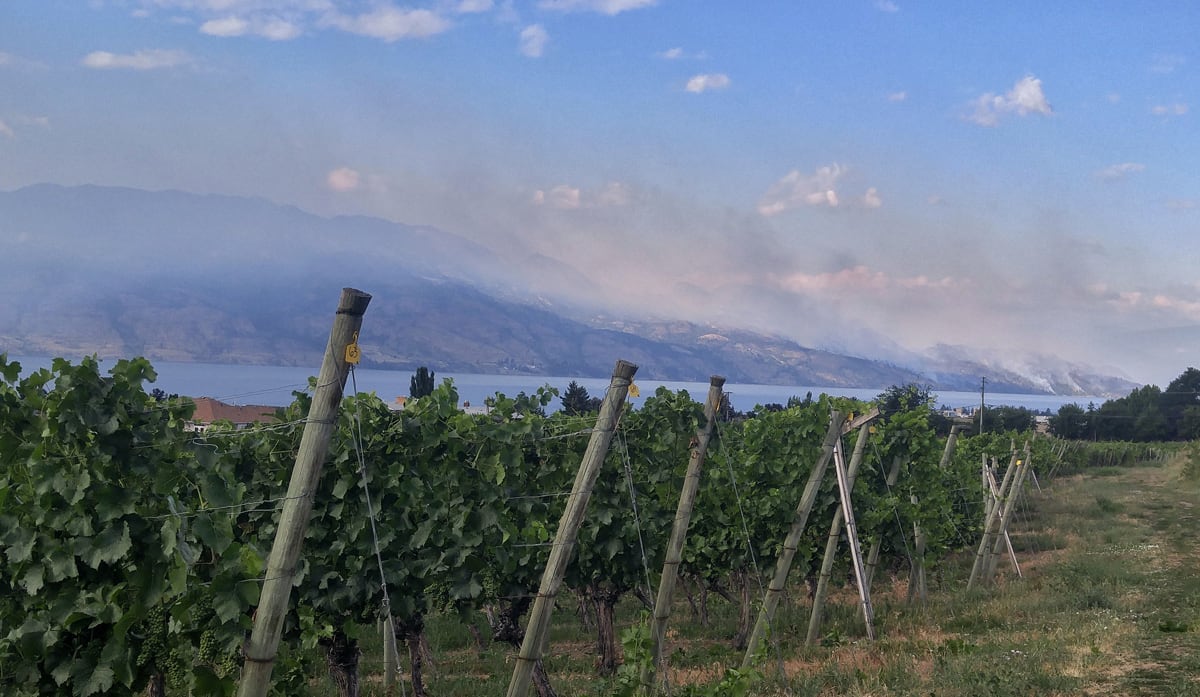
Wine Culture Magazine

istockphoto.com/Schleppitis photo
On October 8, 2017, Ray Signorello was at home in West Vancouver, brining the Thanksgiving turkey and waiting for his wife Tanya to come home from their winery on Napa Valley’s Silverado Trail.
Around 10 p.m. the phone rang. It was Tanya, telling him a fire was burning on the hill behind the winery. “I didn’t think this was such a big deal. We’ve had fires before,” Signorello recalls.
To be on the safe side, he called their winemaker, Pierre Birebent, and asked him to check things out. “He was like me. I could tell in his voice he thought it wasn’t a big deal,” he says. “He starts to drive down the valley and calls me and says ‘Ray, it’s a huge fire. I’m going to call my crew and go down to the winery and hose things down.’ ”
He called to say, ‘Now the fire is at the corner of the building.’ And he called me 15 minutes later, crying, to say, ‘The winery is gone.’
Then, Signorello says, “He called to say, ‘Now the fire is at the corner of the building.’ And he called me 15 minutes later, crying, to say, ‘The winery is gone.’”

Flames continue to burn the morning after the fire at Signorello Estate in Napa. Photo courtesy of Signorello Estate
The lingering pall of smoke. The anxious midnight tweets. The unearthly orange glow in the sky.
From Australia to Napa to the Okanagan Valley, wildfires have become as much a part of life in wine country as Riedel glassware and carefully curated cheese plates.
California, which from 2011 to 2017 suffered the worst drought in the state’s recorded history, has been particularly badly hit. Fires have destroyed tens of thousands of buildings, massive tracts of vegetation and dozens of human lives—85 people died last year in the Butte County Camp Fire alone. California’s wine industry now takes the threat so seriously that when Constellation Brands held its recent technical conference, fire-related issues were high on the agenda.
But B.C. hasn’t escaped unsinged. The Okanagan Valley has seen wildfires each of the last five years, and each year seems to be worse than the last.
In part it’s the weather, or perhaps the climate: B.C. and California alike have recently seen a pattern of rainy springs that prompt lush vegetation, followed by hot, stormy summers, with lightning that ignites all that now-dry spring growth and gusty winds to fan the flames to terrifying heights.
“These things go in cycles,” says Steve Lornie, the co-owner of Okanagan Crush Pad. “And the fact that housing and other developments are encroaching on Mother Nature, we’re getting closer to the danger zone.”

A pall of smoke hangs over the Garnet Valley vineyard as the Okanagan Crush Pad team strategizes how to tackle the fire approaching their boundary in 2018. Photo courtesy of Okanagan Crush Pad
Lornie has become something of an expert on dealing with wildfires. Years ago, he collaborated with local fire and forestry experts on a plan for his property, which included creating a vast, 200,000-gallon pond his team has dubbed “Lake Lornie.” “It turns out, in 2018 it came in very handy,” he says.
In 2017, he watched the Finlay Creek fire approach his 312-acre Garnet Valley Ranch property near Summerland. “That was about five kilometres north of us. At night, you could see it glowing and we didn’t know if we were in the path or not,” he says. They weren’t, but he realized, “If it could happen there, it could happen here.” That fall, he installed additional fire hydrants along the vineyard’s northeast borders.
Once the fire started approaching and getting within a few hundred metres, we started turning the system on. And it seemed to do the trick in not letting embers get a start on the perimeter.
A year later, a fire started up around Enneas Creek, and winds from the north quickly blew it into Garnet Valley. “Once the fire started approaching and getting within a few hundred metres, we started turning the system on. And it seemed to do the trick in not letting embers get a start on the perimeter,” he says.
At the same time, helicopters scooped water from the pond to put out spot fires around the property. Then the wind reversed and the fire service created a back burn, which destroyed any fuel in the fire’s path. “That in the end is what stopped the fire in its track.”
His approach may not work for everyone. “Every property is different; every fire risk is different,” Lornie says. But it’s a good place to start.
Fire is expensive. Aside from the devastating risk to life, it destroys buildings and businesses that may have taken a lifetime to build. Tourism revenue takes a hit when frightened visitors stay away. And even if a vineyard is spared, the grapes can be damaged by smoke taint, whose bitter taste may show up years later in the bottle.
“The growers really need to understand this new threat,” says Melissa Stackhouse, winemaker for Sonoma’s Meiomi Wines, who experienced her first fire season in 2008, and one pretty much every year since. “In 2018, we had to reject a lot of fruit in the field because of smoke taint.”
Fighting fire is expensive, too.
After his winery was destroyed, Signorello flew down to Napa. “It was a lunar landscape kind of feeling,” he recalls. Luckily, the vineyard and tank farm escaped the blaze. “We were fortunate that it was an early harvest so everything was intact. We didn’t have an interruption in product on the one side, but now we didn’t have a facility.”
He’s rebuilding the Signorello Estate winery, this time out of fire-resistant concrete, steel and glass, with exterior sprinklers and water cannons on the roof. The property will feature two pools, which will hold 60,000 gallons of water, caves for storage and a new driveway. “The new mandate says that two fire trucks have to be able to pass each other at 30 miles an hour,” he says. “All these things cost a fortune.”

Right, the Signorello Estate winery on Napa Valley’s Silverado Trail before fire ripped through the property in 2017. Left, what remained afterward. Ray Signorello is now rebuilding, with fire protection firmly in mind. Photos courtesy of Signorello Estate
The funny thing, Signorello says, is that he’d been in New York on 9/11 and in San Francisco during the 1989 earthquake. In 2005, he lost two vintages when a storage facility was torched by an arsonist. And earlier in 2017, he and his family barely escaped a massive inferno that erupted around Williams Lake while they were on a camping trip.
He’d become, perhaps, a bit blasé about fire. But not anymore.
“We were in the biggest fire in B.C. history,” he says, shaking his head as he recalls telephone poles burning like matchsticks beside the highway, “and three months later, our winery burns down.”
The first—and still the worst—major fire in the Okanagan in recent memory was the 2003 firestorm that burned along the eastern ridge of the valley. At around 4 a.m. on August 16, lightning struck near Rattlesnake Island in Okanagan Mountain Provincial Park. Fuelled by relentless wind and the driest summer on record, the flames it sparked roared as far north as East Kelowna, forcing the evacuation of 27,000 residents, destroying 239 buildings and burning more than 64,000 acres of land. The cost of the blaze is estimated at $33.8 million.
Miraculously, no human lives were lost.
While fires are a risk everywhere, there is one saving grace in wine country. “We need more vineyards because vineyards act as a natural firebreak,” says Gary Sitton, winemaker at
Ravenswood Winery in Sonoma County. Irrigated soils, wide-open spaces, juicy fruit and green leaves all slow fire in its tracks.
Aside from all the other damage fire leaves in its path, wineries also have to deal with the threat of smoke taint, the unpalatable flavour that lingering smoke can add to wine.
This is not the pleasant bacony note we love in some wines, especially Syrah, but a harsh, bitter character akin to licking a wet ashtray. It won’t make you sick, but it’s definitely not delicious.
Smoke taint isn’t just the result of residue clinging to the grapes. You can’t simply wash it off. Worse, it’s impossible to detect until it’s too late. That’s because burning wood releases aroma compounds called volatile phenols that permeate the grape skins, then bond with the sugars inside and form molecules called glycosides.
This process, called “glycosylation,” makes the phenols no longer volatile, so the smoke can’t be smelled or tasted. It’s only when the grapes are fermented—and sometimes long after the wine has been bottled—that the phenols are released and work their malignant magic.
For more information, check out the vast volume of work conducted by the Australian Wine Research Institute at awri.com.au.
As a certain bear would say, “Only you can prevent wildfires.” Here’s how.
Take care when discarding cigarettes or burning coals. Make sure fires are out before you leave a campsite. And have water or a fire extinguisher on hand in case a blaze gets out of control.
Keep fuel sources, such as trees and shrubs, away from buildings. Clear pine needles and dead leaves from gutters and decks. Don’t stack firewood next to the house.
Consider fire-resistant materials such as concrete, steel and glass, rather than wood. Install sprinklers, inside and out. On bigger properties, install fire hydrants and, if possible, a pool or pond.
Contact municipal fire departments and the provincial government for localized information. Visit firesmartcanada.ca for general tips, and redcross.ca for advice on what to do in a wildfire situation.
Report a wildfire by calling 1-800-663-5555 or texting *5555. Get up-to-date information by calling the fire information line at 1-888-336-7378, or following @BCGovFireInfo on Twitter or BC Wildfire Service on Facebook.

Joanne Sasvari is editor of Vitis and The Alchemist magazines. She also writes about food and drink for WestJet and Vancouver Sun, and is author of the Wickaninnish and Vancouver Eats cookbooks.

Joanne Sasvari is editor of Vitis and The Alchemist magazines. She also writes about food and drink for WestJet and Vancouver Sun, and is author of the Wickaninnish and Vancouver Eats cookbooks.
Copyright © 2025 - All Rights Reserved Vitis Magazine